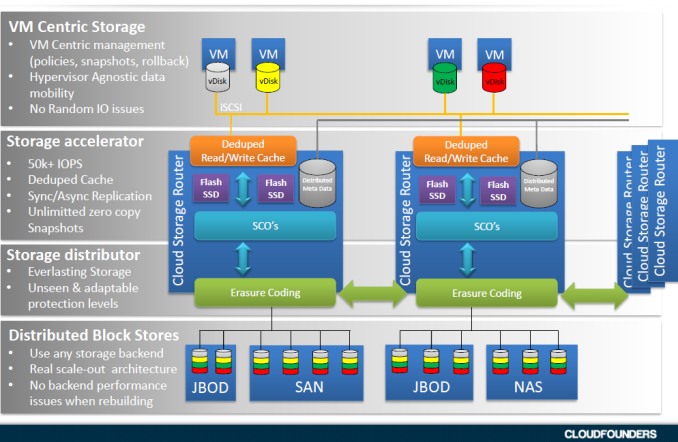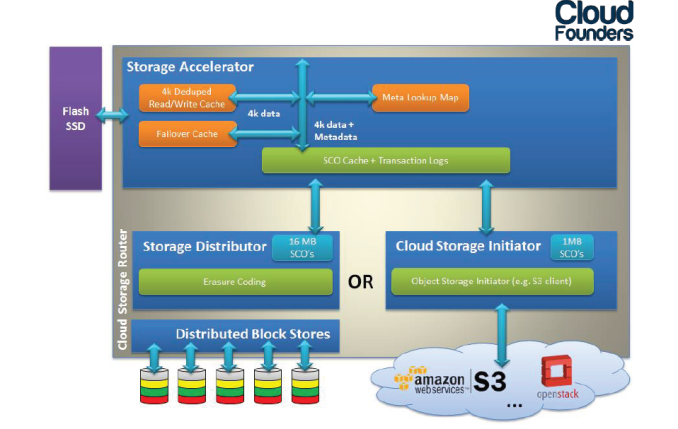The Impact of Disruptive Technologies on the Professional Storage Market
by Johan De Gelas on August 5, 2013 9:00 AM EST- Posted in
- IT Computing
- SSDs
- Enterprise
- Enterprise SSDs
CloundFounders: Cloud Storage Router
The latency of DSS on top of slow SATA disks is of course pretty bad. CloudFounders solves this by using an intelligent flash cache that caches both reads and writes. The so-called “Storage Accelerator” is part of the Cloud Storage Router and runs on top of the DSS backend.
First of all, the typical 4KB writes are all stored on the SSD. The 4KB are aggregated into a Storage Container Object (SCO), typically 16MB in size. As a result, the flash cache is used for what it can do best (working with 4KB blocks) and the DSS SATA backend will only see sequential writes of 16MB. The large SATA magnetic disks perform a lot better with large sequential writes than small random ones.
A server with virtual machines can connect to several Cloud Storage Routers. Blocks of a virtual disk can be spread over several flash caches. The result is that performance can scale with the number of nodes where Cloud Storage Routers are active. The magic to make this work is that the metadata is distributed among all cloud storage routers (using a Paxos distributed database), so “hot blocks” can be transferred from several flash caches of several nodes at the same time. The metadata also contains a hash of each 4KB block. As hash codes of each 4KB block in the cache are compared, the cache is “deduped” and each 4KB block is written only once.
As the blocks of virtual disk are distributed over the DSS, the failure of compute or storage nodes does not need to be disruptive. Compute node failure can be solved by enabling VMware HA, storage nodes failures can be solved by configuring the DSS durability policy. As the metadata is distributed, the remaining cloud storage routers will be able to find the blocks on the DSS that belong to a certain virtual disk.
Last but not least, the Cloud Storage Routers can also distribute the check blocks over cloud storage like Amazon S3 or an Openstack Swift implementation. The data is also secure as the blocks are encoded and spread over many volumes. Only the Cloud Storage Routers know how to assemble the data.
Highly scalable, very reliable, and very flexible (e.g. when used with Amazon S3): the CloudFounder Storage Router sounds almost too good to be true. We have setup a Storage Router in our lab and can confirm that it can do some amazing things like replicating an ESXi VM across the globe and booting it as a Hyper-V VM. We are currently designing some benchmarks to compare it with traditional storage systems, so we hope to report back with some solid tests. But it is safe to say that the combination of Bitspread and the Cloud Storage Router is very different from the traditional RAID enabled SAN and storage gateway.












60 Comments
View All Comments
WeaselITB - Tuesday, August 6, 2013 - link
Fascinating perspective piece. I look forward to the CouldFounders review -- that stuff seems pretty interesting.Thanks,
-Weasel
shodanshok - Tuesday, August 6, 2013 - link
Very interesting article. It basically match my personal option on SAN market: it is an overprice one, with much less performance per $$$ then DAS.Anyway, with the advent of thin pools / thin volumes in RHEL 6.4 and dmcache in RHEL 7.0, commodity, cheap Linux distribution (CentOS costs 0, by the way) basically matche the feature-set exposed by most low/mid end SAN. This means that a cheap server with 12-24 2.5'' bays can be converted to SAN-like works, with very good results also.
In this point of view, the recent S3500 / Crucial M500 disks are very interesting: the first provide enterprise-certified, high performance, yet (relatively) low cost storage, and the second, while not explicitly targeted at the enterprise market, is available at outstanding capacity/cost ratio (the 1TB version is about 650 euros). Moreover it also has a capacitor array to prevent data loss in the case of power failure.
Bottom line: for high performance, low cost storage, use a Linux server with loads of SATA SSDs. The only drawback is that you _had_ to know the VGS/LVS cli interface, because good GUIs tend to be commercial products and, anyway, for data recovery the cli remains your best friend.
A note on the RAID level: while most sysadmins continue to use RAID5/6, I think it is really wrong in most cases. The R/M/W penalty is simply too much on mechanincal disks. I've done some tests here: http://www.ilsistemista.net/index.php/linux-a-unix...
Maybe on SSDs the results are better for RAID5, but the low-performance degraded state (and very slow/dangerous reconstruction process) ramain.
Kyrra1234 - Wednesday, August 7, 2013 - link
The enterprise storage market is about the value-add you get from buying from the big name companies (EMC, Netapp, HP, etc...). All of those will come with support contracts for replacement gear and to help you fix any problems you may run into with the storage system. I'd say the key reasons to buy from some of these big players:* Let someone else worry about maintaining the systems (this is helpful for large datacenter operations where the customer has petabytes of data).
* The data reporting tools you get from these companies will out-shine any home grown solution.
* When something goes wrong, these systems will have extensive logs about what happened, and those companies will fly out engineers to rescue your data.
* Hardware/Firmware testing and verification. The testing that is behind these solutions is pretty staggering.
For smaller operations, rolling out an enterprise SAN is probably overkill. But if your data and uptime is important to you, enterprise storage will be less of a headache when compared to JBOD setups.
Adul - Wednesday, August 7, 2013 - link
We looked at Fusion-IO ioDrive and decided not to go that route as the work loads presented by virtualize desktops we offer would have killed those units in a heartbeat. We opted instead for a product by greenbytes for our VDI offering.Adul - Wednesday, August 7, 2013 - link
See if you can get one of these devices for review :)http://getgreenbytes.com/solutions/vio/
we have hundreds of VDI instances running on this.
Brutalizer - Sunday, August 11, 2013 - link
These Greenbyte servers are running ZFS and Solaris (illumos)http://www.virtualizationpractice.com/greenbytes-a...
Brutalizer - Sunday, August 11, 2013 - link
GreenByte:http://www.theregister.co.uk/2012/10/12/greenbytes...
Also, Tegile is using ZFS and Solaris:
http://www.theregister.co.uk/2012/06/01/tegile_zeb...
Who said ZFS is not the future?
woogitboogity - Sunday, August 11, 2013 - link
If there is one thing I absolutely adore about real capitalism it is these moments where the establishment goes down in flames. Just the thought of their jaws dropping and stammering "but that's not fair!" when they themselves were making mockery of fair prices with absurd profit margins... priceless. Working with computers gives you so very many of these wonderful moments of truth...On the software end it is almost as much fun as watching plutocrats and dictators alike try to "contain" or "limit" TCP/IP's ability to spread information.
wumpus - Wednesday, August 14, 2013 - link
There also seems to be a disconnect in what Reed-Solomon can do and what they are concerned about (while RAID 6 uses Reed Solomon, it is a specific application and not a general limitation).It is almost impossible to scale rotating discs (presumably magnetic, but don't ignore optical forever) to the point where Reed-Solomon becomes an issue. The basic algorithm scales (easily) to 256 disks (or whatever you are striping across) of which typically you want about 16 (or less) parity disks. Any panic over "some byte of data was mangled while a drive died" just means you need to use more parity disks. Somehow using up all 256 is silly (for rotating media) as few applications access data in groups of 256 sectors a time (current 1MB, possibly more by the time somebody might consider it).
All this goes out the window if you are using flash (and can otherwise deal with the large page clear requirement issue), but I doubt that many are up to such large sizes yet. If extreme multilevel optical disks ever take over, things might get more interesting on this front (I will still expect Reed Solomon to do well, but eventually things might reach the tipping point).
equals42 - Saturday, August 17, 2013 - link
The author misunderstands how NetApp uses NVRAM. NVRAM is not a cache for the hottest data. Writes are always to DRAM memory. The writes are committed to NVRAM (which is mirrored to another controller) before being acknowledged to the host but the write IO and its commitment to disk or SSD via WAFL sequential CP writes is all from DRAM. While any data remains in DRAM, it can be considered cached but the contents of NVRAM do not constitute nor is it used for caching for host reads.NVRAM is only to make sure that no writes are ever lost due to a controller loss. This is important to recognize since most mid-range systems (and all the low-end ones I've investigated) do NOT protect from write losses in event of failure. Data loss like this can lead to corruption in block-based scenarios and database corruption in nearly any scenario.